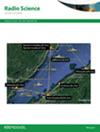Quad ports millimeter-wave MIMO antenna with parasitic element and defected ground structure for radar sensing application
IF 1.5
4区 地球科学
Q3 ASTRONOMY & ASTROPHYSICS
引用次数: 0
Abstract
This paper presents a quad-element MIMO antenna with a novel decoupling structure for mm-wave 5G radar sensing applications. The proposed MIMO antenna is fabricated on Rogers RT/5880, which is suitable for high frequency communication. Furthermore, effective techniques for novel parasitic elements and a defected ground structure (DGS) are introduced to minimize inter-element coupling in the required bandwidth. The parasitic element consists of a square ring and a four-line parasitic. The ring parasitic is rotated 45° anticlockwise and line parasitic elements are rotated 5° from the original position to obtain the proposed design. The line parasitic elements coupled from adjacent elements and square ring parasitic neutralize current. The DGS is introduced to enhance isolation further. The slot is inserted in the center of the ground plane. Two rectangular slots are also inserted to isolate adjacent elements. The edge-to-edge space between the radiation elements is 5.6 mm. The antenna exhibits S11 of <—10>9.99 dB and multiplexing efficiency is —0.5 dB within the given bandwidth. The multiplexing efficiency, radiation pattern, ECC, DG, and peak gain are also calculated and evaluated for practical authentication.四端口毫米波MIMO天线的寄生元件和缺陷的地面结构的雷达传感应用
提出了一种具有新型解耦结构的四元MIMO天线,用于毫米波5G雷达传感。所提出的MIMO天线是在Rogers RT/5880上制作的,适用于高频通信。此外,引入了新型寄生元件和缺陷接地结构(DGS)的有效技术,以最大限度地减少所需带宽中的元件间耦合。寄生元件由一个方环和一个四线寄生组成。环形寄生元件逆时针旋转45°,线寄生元件从原始位置旋转5°,得到了所提出的设计。从相邻元件耦合的线寄生元件和方环寄生元件中和电流。引入DGS以进一步增强隔离。槽位位于接平面的中央。还插入了两个矩形槽来隔离相邻的元素。辐射元件之间的边缘到边缘间距为5.6 mm。在给定带宽内,天线的S11为9.99 dB,复用效率为-0.5 dB。对复用效率、辐射方向图、ECC、DG和峰值增益也进行了计算和评估。
本文章由计算机程序翻译,如有差异,请以英文原文为准。
求助全文
约1分钟内获得全文
求助全文
来源期刊

Radio Science
工程技术-地球化学与地球物理
CiteScore
3.30
自引率
12.50%
发文量
112
审稿时长
1 months
期刊介绍:
Radio Science (RDS) publishes original scientific contributions on radio-frequency electromagnetic-propagation and its applications. Contributions covering measurement, modelling, prediction and forecasting techniques pertinent to fields and waves - including antennas, signals and systems, the terrestrial and space environment and radio propagation problems in radio astronomy - are welcome. Contributions may address propagation through, interaction with, and remote sensing of structures, geophysical media, plasmas, and materials, as well as the application of radio frequency electromagnetic techniques to remote sensing of the Earth and other bodies in the solar system.
 求助内容:
求助内容: 应助结果提醒方式:
应助结果提醒方式:


